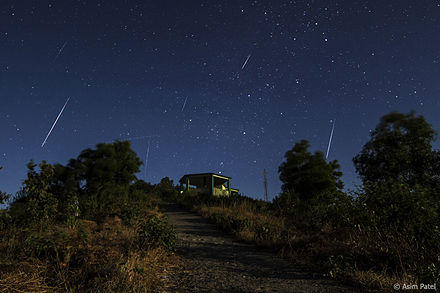For more information about viewing Meteor Showers and the different meteor showers that can be viewed over the course of a year, check out our article on the topic. This article is going to focus on the Top 5 Must View Meteor Showers in regards to why they are must a view for any astronomer, and information about the meteor showers.
- Perseids
Running from July 14th to August 24th and averaging 50-100 meteors per hour during its peak, its clear that the Perseids are the #1 most beautiful meteor shower. Although maybe not the most plentiful shower in terms of the number of average meteors per hour during its peak, the Perseids are visible during the time of year that has nice weather and few clouds. Moreover, the meteors are visible early in the evening, during the pre-dawn hours, which makes this a family affair. The Perseids radiate from the constellation Perseus, which will be rising in the North for those in the Pacific Northwest. - Quadratids
The Quadratids were almost #1 on this list of the most beautiful meteor showers, but due to weather and short peak viewing window, the shower is #2 on our list. The Quadratids meteor shower runs from December 28th to January 12th radiating from the constellation Bootes. The best time to view these meteors would be during the night and predawn hours.
At its peak, there can be anywhere from 60-200 meteors per hour, but the window to see this peak is only a few hours each year, as compared to 2 days for other popular showers such as the Perseids. A big negative for the Quadratids is that the weather in the Pacific Northwest in this timeframe can not only be extremely cold, but also cloudy every night. This cloudiness prevents reliable annual viewing of these meteors. Unlike the Perseids, which one can expect good weather, the Quadratids can be hit or miss, but if good weather, this can be a great show! - Geminids
With up to 120 meteors per hour during its peak, the Geminids are considered one of the most reliable and plethora meteor showers of the year. With more meteors than the Perseids, but similar timing to the Quadratids, viewers in the Pacific Northwest can expect similar weather and issues as the Quadratids. The Geminds run from December 4th to December 17th and radiate from the constellation Gemini. As the constellation of Gemini rises in the East at the start of the night and sets in the West in the morning, just look up as the showers will be right overhead. The best time to view is during the night and predawn hours, as the showers typically starts at around 9pm or 10pm.
In terms of weather, make sure to be dressed warmly and comfortably as this can be a cold time of year and with all the rain in the winter, considerations need to be taken for the weather and staying warm. - Orionids
Viewable after midnight, the Orionids are a beautiful sight to see, not for the number of meteors, but rather for the brightness and speed. Visible for those in the Pacific Northwest during hours after midnight, radiates from a bit north of constellation Orion’s bright star Betelgeuse. At this time, the constellation Orion will be rising, so look low on the Eastern horizon at this time and the constellation will rise as the night progresses. Running from October 2nd to November 7th, the Orionids are still early enough in the year that if the Fall weather in the Pacific Northwest does not start to rain, these meteors will definitely be visible. Remember to pack warmly! - Lyrids
The Lyrids are one of the oldest ever meteor showers to ever be recorded in written human history and could potentially provide one really great show! The reason for the inclusion in this list is that although the number of meteors typically peak at 20 per hour, there is the potential for up to 100 meteors per hour peak. However, it is worth noting that it is relatively rare to have 100 meteor per hour peak. But with that potential, it is definitely worth including in our list.
The best time to view these meteors is after moonset and before dawn. The meteor shower runs from April 16 to April 25, which can be either hit or miss for the Pacific Northwest weather as either cloudy one day and clear the next. But if it is clear, these meteors can be seen rising from the North early at night and rising to directly overhead all night. It can definitely be a good show!
Those that missed the list include the Draconids because although they can create a plethora of meteors, the average number during the average years are similar to those on this list. However, when they do spike, the Draconids are extremely high in number and might only be visible at not the best times, such as the day, for those in the Pacific Northwest.

Be the first to comment on "Top 5 Most Beautiful Meteor Showers"